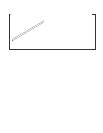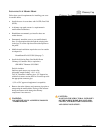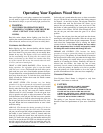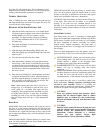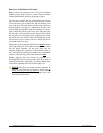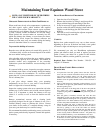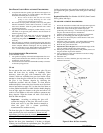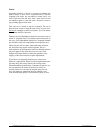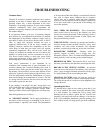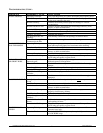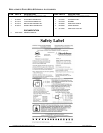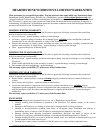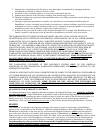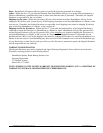
HearthStone Quality Home Heating Products, Inc ® Equinox Model 8000
23
TROUBLESHOOTING
Common Issues
Virtually all woodstove operators experience basic common
problems at one time or another. Most are correctable and
generally require only a minor adjustment of the stove,
installation, or operating technique. In cases where weather
conditions dramatically affect stove performance, the
problems are typically temporary and solve themselves once
the weather changes.
If you question whether your stove is producing adequate
heat, the best way to troubleshoot the problem is to monitor
the temperature of the chimney connector (single wall) no
more than 12 inches (30 cm) above the flue collar. A 400° F
(200° C) single wall stovepipe confirms the stove is
supplying sufficient heat. If you are using a double wall
chimney connector, measure the temperature at the flue
collar. Keep in mind that your house itself will regulate
room/house temperatures. How well the walls, floors and
ceilings are insulated, the number and size of windows, the
tightness of outside doors, and the construction or style of
your house (vaulted ceilings or other open spaces which
collect large percentages of heat, ceiling fans, etc.) all are
determining factors of room temperature.
Your stove's performance is also dependant on its
installation. One common cause of poor performance is an
oversized chimney flue. Oversized chimney flues result in
decreased draft, which prevents the smoke from rising out
the chimney. Oversized flues are also more difficult to heat
effectively, especially when burning a high efficiency stove.
Cool flue temperatures inhibit the establishment of a strong
draft (and encourage the accumulation of creosote). The lack
of a strong draft will cause the fire to die down and may even
force smoke to pour into the room.
If your chimney is the proper size and a strong draft is not
easily established, there is the possibility that the chimney is
too cold. Again, hot chimneys promote stronger drafts.
Opening a window briefly while lighting the stove may help.
Other draft guidelines are as follows:
An "AIRTIGHT" HOUSE: The air supply (infiltration) to
the interior of the house may be inadequate if your home is
super-insulated or especially well sealed. This phenomenon
of air starvation within the building is exacerbated if exhaust
fans, such as clothes dryers, bathroom fans or cookstove
exhaust fans, are in operation within the home. Outfitting
your stove with the optional outside air adaptor connected to
an air duct, which leads to the outside of the building, can
correct this problem.
TALL TREES OR BUILDINGS: These obstructions,
when located close to the top of the chimney can cause
chronic or occasional downdrafts. When selecting a site for a
new chimney, consider the placement of other objects near
the proposed chimney location.
WIND VELOCITY: Generally, the stronger and steadier a
wind, the stronger (better) the draft. However, "gusty" wind
conditions can cause erratic downdrafts. For consistent
problems, consider a high wind cap, such as the Vacu-Stack.
BAROMETRIC PRESSURE: Chimney drafts are
typically sluggish on balmy, wet or muggy days (low
barometric pressure). This is a weather-related phenomenon,
which generally is self-correcting as the weather changes.
BRISKNESS OF FIRE: The hotter the fire in your stove,
the hotter your chimney and, therefore, the stronger the draft.
BREAKS IN THE VENTING SYSTEM: An unsealed
clean-out door at the bottom of the chimney, leaky stovepipe
joints, a poor stovepipe-to-thimble connection, missing caps,
or a leaky chimney all can cause inadequate draft.
SEASONAL FACTORS: Early fall and late spring are
generally difficult seasons in which to establish proper drafts.
The colder the outside air is relative to room temperature, the
stronger the draft.
Operating the Stove
As outlined above, there are days when a good draft is just
not easy to establish. The causes are usually seasonal factors
or a cold chimney. Try starting the fire by using small
kindling and fuel to obtain a quick, hot fire. Tend the fire
frequently with small fuel until the chimney is hot and the
draft is well established. Sometimes, partially opening a first
floor window briefly will help quickly get draft established.



